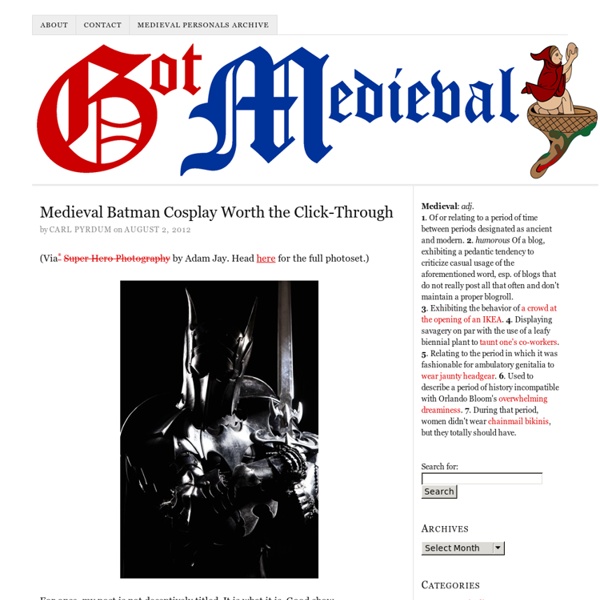



Howstuffworks "How Knights Work" When you think of knights, you might envision King Arthur, Sir Lancelot or the Black Knight. We often think of heroic knights in shining armor fighting each other with swords or riding their horses on noble quests. Our images of knights have been influenced over centuries by romance authors (like T.H. Medieval knights were, first and foremost, warriors. Knights were most noted for fighting on horseback, but they also battled on foot. In this article, we'll examine the lives of knights.
The Bowery Boys: New York City History Modern Medieval Medieval Civilization: Lecture Notes Lecture Notes The Legacy of the Roman Empire and the Middle Ages in the West (ca AD 500-1450/1500) The World in Transition, AD 395-1500 Introduction The Three Heirs to the Roman Empire: 6th-7th centuries: a new period in the history of world civilization; clear that no one empire would rule the Mediterranean world; by the 7th century, three successor civilizations, the Byzantine, the Islamic, and the western European, had developed, each with its own culture, its own religion, and its own language; these three civilizations quickly became rivals. The Byzantine Empire and the Mediterranean World at the Death of Justinian I. Islamic civilization: (7th century-ca. 1500) founded by the prophet Muhammad; language was Arabic; government and culture permeated with this dynamic new religion; it created an Empire in the old Near East, along the African coasts of the Mediterranean, & it spread into the Indian subcontinent. The Eastern Heirs of the Roman Empire Byzantine Civilization (5th century-1453)
Mavisbank, a Tragically Neglected 18th c Country House Susan reporting: For many of us American history-nerds, the great British country houses seem to exist in an almost supernatural state of romantic perfection. They're the idealized places we imagine in Jane Austen's novels and see as backgrounds in films (among them: Brideshead Revisited, The Duchess, Pride and Prejudice, The Go-Between.) As an art history major in college, I sat in darkened classrooms and gazed in awe at slides of Palladio-inspired majesty, nestled in flawless green landscapes. But reality is often not so kind. A devastating fire in 1973 gutted the interiors and destroyed the roof. Mavisbank's salvation finally seems assured. Top: Mavisbank House, Midlothia, Scotland, drawing by William Adam, from Vitruvius Scoticus (1812)Below: Mavisbank House, Midlothian, Scottland.
Geoffrey Chaucer Hath a Blog ‘Except Only a Cat’ – Nun’s Pets in the Middle Ages - From The Ark Number 209 - Summer 2008 - A Publication of Catholic Concern for Animals - Formerly: The Catholic Study Circle for Animal Welfare - Providing Christian education, research, study, instruct The Rt Rev Dom Joseph Delargy, is Abbot of the Mount St Bernard Abbey, Leicestershire, of the Cistercians of Strict Observance. Here he shares with us a lighthearted talk he gave to his community recently. In the middle ages in England there were at least 140 convents of nuns that we know of. On the whole these convents were not very large and only four of them had communities of more than 30 nuns. It has been calculated that the average size of a convent community in those days was about 14 nuns. In the wonderful book Medieval English Nunneries by Eileen Power,* a history professor from Cambridge back in the 1920’s, we have details of all aspects of the nun’s life. As is still the case today all monasteries of monks and nuns would be visited by another superior or bishop once every one or two years. They were * Dancing, * Dresses and * Dogs. It was this third one, dogs, that I found most intriguing. The Ancren Riwle, or Nun’s Rule, was the English rule for nuns written in about 1300.
Two Nerdy History Girls Old English in New York Researching the Medieval Even after writing three medieval historical romances, soon to be four, I hardly consider myself an expert on researching the medieval novel. But I have learned a few tricks along the way that I'd like to share with you. When I first began researching this period about fifteen years ago, there were very few resources available to the non-historian. However you begin your research, it should be an on-going process. Here are a few handy tips as you begin your novel: This sounds simplistic, but it's good advice. It's true that many medieval readers are extremely dedicated and well educated. The Oxford English Dictionary, or OED, is a massive so-called dictionary that consists of some 20 humongous volumes that take up two rows in the library. I do general research in various medieval history books. Let's look at an example. If you're really compulsive, like I am, you'll go crazy sometimes. Religion: Religion and church were fundamental aspects of life in the Middle Ages. Finally, good luck!
Boston 1775